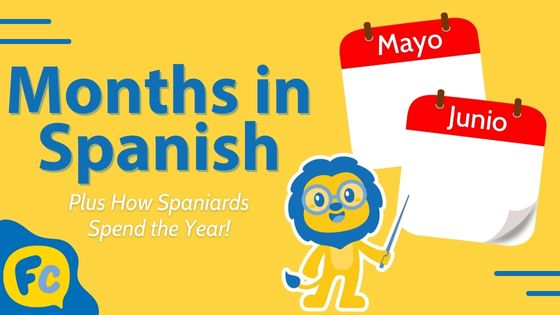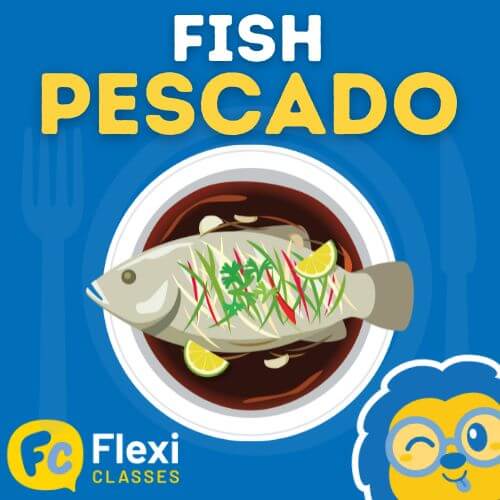Food in Spanish || Essential Vocabulary & Must-Eat Dishes
Spanish Food Vocabulary || And The Million Dollar Question: What Time Do People Eat in Spain?

Spain is Different- once a national slogan.
True to that phrase, you’re going to need some adjustments when it comes to mealtimes in Spain. Meals are a serious business in Spain and are not rushed, only to be enjoyed.
Of course, Spaniards follow the regular sequence of meals, breakfast, lunch and dinner but with a caveat… all in their own time.
So if you want to blend in, you might want to synch your internal clock to Spanish meal times right away!
In today’s blog post we’re going to teach you all the Spanish food vocabulary you need to know, as well as take a deep dive into Spanish food culture 🥘
Food in Spanish || Breakfast (Desayuno), Light and Double
Food in Spanish || El Almuerzo, It’s Lunch Time
Food in Spanish || The Mediterranean Diet for Dinner
Food in Spanish || The Beloved Aperitivo
Food in Spanish || Merienda, the Spanish Afternoon Snack
Food in Spanish || La Sobremesa, Hang Around for a Little Longer
Food in Spanish || 10 Spanish Dishes You Have to Try
Food in Spanish || Your Essential Food Vocabulary
Food in Spanish || FAQs
Food in Spanish || Breakfast (Desayuno), Light and Double
Round one: Breakfast time is typically between 7-9 am.
Options are usually light, a toast of bread with some olive oil, a croissant, a small pastry, a light bowl of cereal, perhaps, usually accompanied with some coffee (the café con leche option is the go-to) or some juice (orange juice is the usual).
Round two: It’s fairly common practice to hop into a nearby bar or café and have a second go at breakfast – usually a little before noon. Again, another light brekkie, typically a savoury one.
The breakfast double-up may consist of a small baguette sandwich, with a spread of grated tomato and filled with some embutidos (local cold-cuts), cheese, tuna, omelette or your typical grilled ham and cheese sandwich, etc. all accompanied with some (more) coffee ☕
There are variants of course to this. In Madrid, it would be customary to also have the option of churros or porras (a bigger and fluffier version of churros) for breakfast, usually with your coffee as well.
Food in Spanish || El Almuerzo, It’s Lunch Time
This is where you will need the most adjustments if you’re used to a more continental lunchtime clock. Unlike the rest of the world, lunch ( el almuerzo or la comida ) in Spain typically starts at 2 pm and can extend until 3:30 pm or close to 4 pm.
Lunch is a sit-down meal and is heavier, compared to breakfast. The concept of eating while walking or on the go is a foreign idea to a Spaniard. They take their meals seriously and do not rush them.
Ante todo mucha calma (keep calm, above all!), is often said in Spain.
If having lunch in a restaurant on a weekday, expect to find a fairly priced menu del día (set menu for the day), with a lighter first course, a heftier main course and dessert/coffee and always, always, bread on the side.
Culture tip: Having a beer or a glass of wine with your lunch is common 🍷
Food in Spanish || The Mediterranean Diet for Dinner
An acceptable time to have dinner in Spain would be between 9 and 11 pm, as offices and businesses normally shut down at around 8 pm. Restaurants also serve dinner past 9 pm. Perhaps a more tourist-oriented one will serve earlier meals but that is not the norm.
So what do Spanish households typically eat?
The world-renowned Spanish diet (the Mediterranean Diet) is still among the healthiest in the world and is still very much part of the everyday cuisine in Spain.
According to a survey published by the Ministry of Agriculture, Fishery and Food, the most consumed foods by regular Spanish households are: green and tomato salads, chicken breasts and lentils, followed by pasta, hake (merluza), potato omelette and pork loin.

Months in Spanish 📆 || Key Vocabulary and Cultural Insights
Learn How to Say the Months in Spanish and Find Out How Spaniards Spend the Year No matter if you’re talking about birthdays, business trips or holiday plans, months are essential vocabulary you need to know in Spanish. So in…
Food in Spanish || The Beloved Aperitivo
Although the pre-meal appetizer aperitivo is not exclusive to the Spanish dining culture, as other European countries (like Italy) also have this tradition, it is very ingrained into any Spanish meal plan.
In a typical aperitivo, you can expect small savoury morsels of food usually accompanied by a glass of spirits (like vermouth, sherry, bubbly cava, beer or your choice of wine). The point is to open up one’s appetite for the meal to come, so quantities are not too plentiful.
The ultimate purpose of an aperitivo, aside from working up an appetite for the bigger meal, is to foster social interactions in a more relaxed and informal setting before a more traditional sit-down meal.
Food in Spanish || Merienda, the Spanish Afternoon Snack
Although the Spanish afternoon snack or merienda would not be very common in the work environment, it is almost a must-have for kids, who come home starving after school and have a long stretch before dinner.
Either way and in more recent times, cafés all around Spain usually enjoy their fair share of client influx in the afternoons, either for a pick-me-up coffee or a light afternoon snack (and coffee).
Culture tip: The expression, Quedamos para tomar un café (‘Let’s meet up for some coffee’) is one that you will hear and probably use fairly often when in Spain. There is a very much ingrained culture of drinking coffee and conversations around coffee. ☕
Food in Spanish || La Sobremesa, Hang Around for a Little Longer
In most countries, usually after a sit-down meal at home or in a restaurant, you maybe have a coffee, exchange a few more words and leave the table.
Correct? Well, not in Spain.
More often than not, Spaniards enjoy the sobremesa .
This is the act of hanging out a while longer after a meal, gathered around the table and, in a more relaxed setting, conversing and enjoying the company of those you dined with.
A literal translation of sobremesa would be “over the table”
👉 In the sobremesa, the main focus is no longer the food itself but the company of those you dined with, making the most of the social or family gathering. Sobremesas are commonplace, any day of the week, but probably more extensive in duration over a weekend meal.
Culture tip: When in a restaurant with friends/family, don’t rush to get the bill after your meal. Practice enjoying la sobremesa, the fine art of conversing “over the table” after a meal.

Months in Spanish 📆 || Key Vocabulary and Cultural Insights
Learn How to Say the Months in Spanish and Find Out How Spaniards Spend the Year No matter if you’re talking about birthdays, business trips or holiday plans, months are essential vocabulary you need to know in Spanish. So in…
Food in Spanish || 10 Spanish Dishes You Have to Try
Let’s narrow it down, here is a list of absolute must-tries when you are in Spain.
Tortilla de patatas: Plain and simple, it’s a potato omelette and a national staple, simple and delicious. Potatoes are diced or thinly sliced, poached in olive oil and then mixed with eggs, for a quick fry together. Each household has its own technique. No two tortilla de patatas are alike, ever!
Paella: Is a dish originally from Valencia, it’s rice-based and flavoured with a rich broth and ingredients of choice (usually shrimp, chicken, red peppers, calamari, muscles…) and cooked in a flat round pan.
It was originally referred to as the “poor man’s dish” because this rice-based dish was cooked with the food discards of the day. Nowadays, it is probably Spain’s most international dish.
Gazpacho: A unique tomato-based soup with blended-in garlic, red peppers, cucumber and olive oil, usually served topped with croutons.
Jamón: Practically every bar and restaurant in Spain will serve this Spanish cured ham morsel, usually accompanied by a bit of bread spread with tomato (pan con tomate).
Patatas Bravas: One of the nation’s staples and almost synonymous with tapas. It’s a dish served with crispy diced potatoes and a mix of aioli and a (mildly) hot red sauce. Best when accompanied together with a clara (Spanish term for the beverage shandy).
Fabada a la Asturiana: A rich and hearty white bean stew from the Asturian region (north of Spain) that gets its rich flavours from the chunks of chorizo and pork the beans are stewed in. Perfect for the winter.
Pimientos del Padrón: These sweet and aromatic miniature green peppers are sauteed in olive oil and sprinkled with some coarse salt. What’s so special about them? Well, the fun part is that an occasional one will be fiery hot. How to tell if one is fiery hot or sweet and mild? Well, you can’t… at least until you take the first bite.
Churros: Ah, where to begin. It’s a fried bread of sorts, the dough is deep fried into thin, golden brown and crispy sticks, usually served with hot chocolate or if in the meseta area, dunked into your coffee. Definitely a must-try.
Cocido Madrileño: This dish is a hybrid stew-soup of sorts and combines all good things, rendering a rich, filling and comforting meal all in one. The broth gets its rich flavor from the meat, sausages, cured pork belly (panceta), vegetables, potatoes and chickpeas that the soup is boiled in for hours and hours.
Empanada a la Gallega: This would be Spain’s answer to an English meat pie or even to the French quiche but with more earthy flavours. It’s a simple and humble dish but oh so heartwarming and good. It’s made with a thin pastry and usually filled with tuna and red peppers.
Food in Spanish || Your Essential Food Vocabulary
Whether it’s to go grocery shopping, to know how to properly order in a restaurant and understand what a restaurant menu has to offer or just for the sake of knowing, here is your essential food glossary:
Meat and Fish
| Spanish | English |
|---|---|
| Carne | Meat |
| Pescado | Fish |
| Huevos | Eggs |
| Queso | Cheese |
| Embutidos | Cold Cuts |
| Pollo | Chicken |
| Cerdo | Pork |
| Cordero | Lamb |
| Bacalao | Cod |
| Merluza | Hake |
| Rape | Monkfish |
| Gambas | Shrimp |
| Ternera | Veal |
| Mejillones | Mussels |
| Marisco | Seafood |
| Sardinas | Sardines |




Cereals and Grains
Bread, rice, pasta and noodles are some of the biggest staples worldwide.
So, let’s learn these and more…
| Spanish | English |
|---|---|
| Arroz | Rice |
| Maíz | Corn |
| Cereals | Cereal |
| Avena | Oats |
| Harina | Flour |
| Trigo | Wheat |
| Quinoa | Quinoa |
| Pan | Bread |
| Pasta | Pasta |
| Fideos | Noodles |


Pastries and Desserts
Take notes if you have a sweet tooth!
| Spanish | English |
|---|---|
| Donut | Doughnut |
| Croissant | Croissant |
| Magdalenas | Spanish-style Muffins |
| Ensaimada | Pastry typical from the Balearic islands |
| Churros | Churros |
| Tarta de Santiago | Almond Cake |
| Tarta de Queso | Cheesecake |
| Buñuelos | Fritters |
| Crema Catalana | Similar to a Crème Brûlée |
| Tarta de Manzana | Apple Tart |
| Torrijas | Spain’s take on the French Toast |
| Flan | similar to a Custard |
👉 Want to practice speaking about food with native speaker Spanish teachers? Check out our online Flexi Classes platform
Tapas 101:
| Spanish | English |
|---|---|
| Patatas Bravas | Literally translate to ‘bold potatoes’ – probably due to the spicy sauce that goes with it! |
| Pimientros del Padrón | Padrón-style Peppers |
| Tortilla de Patatas | Potato Omelette |
| Berberechos | Cockles |
| Croquetas | Croquettes |
| Albondigas | Meatballs |
| Ensaladilla Rusa | Potato Salad |
| Aceitunas | Olives in Brine |
| Gambas al Ajillo | Shrimp sauteed in garlic and chilies |
| Pulpo a la Gallega | Octupus, Galician-style |
| Jamón | Cured Ham, similar to the Italian Prosciutto |
| Pan con Tomate | Bread with grated tomato and olive oil |
| Boquerones | Anchovies marinated in vinegar |
| Anchoas | Anchovies cured in salt |
| Queso Manchego | Manchego Cheese |
| Calamares a la Romana | Fried Calamari |


Veggies, Fruits, Legumes and Condiments
Spain has many Perfect for that trip down to the grocery store or to your ‘hood market:
| Spanish | English |
|---|---|
| Manzana | Apple |
| Pera | Pear |
| Naranja | Orange |
| Melocotón | Peach |
| Uvas | Grapes |
| Almendras | Almonds |
| Nueces | Nuts |
| Setas | Mushrooms |
| Patatas | Potatoes |
| Lechuga | Lettuce |
| Zanahorias | Carrots |
| Pimiento Rojo | Red Pepper |
| Pimiento Verde | Green Pepper |
| Tomate | Tomato |
| Pepino | Cucumber |
| Calabacín | Zucchini |
| Berenjena | Eggplant |
| Repollo | Cabbage |
| Judías Verdes | Green Beans |
| Brócoli | Broccoli |
| Alcachofas | Artichokes |
| Coliflor | Cauliflower |
| Remolacha | Beetroot |
| Apio | Celery |
| Espinacas | Spinach |
| Cebolla | Onion |
| Ajo | Garlic |
| Perejil | Parsley |
| Cebolleta | Spring Onion |
| Jenjibre | Ginger |
| Garbanzos | Chickpeas |
| Lentejas | Lentils |
| Alubias Blancas | White Beans |
| Pimienta | Pepper |
| Sal | Salt |
| Laurel | Bayleaf |
| Pimentón | Paprika |
| Canela | Cinnamon |
| Tomillo | Thyme |
| Romero | Rosemary |
| Orégano | Oregano |
| Azafrán | Saffron |
| Aceite de Oliva | Olive Oil |


Food in Spanish || FAQs:
What is a typical Spanish merienda?
Traditionally this late afternoon snack was usually comprised of a sandwich (bocadillo), some milk and cookies (the famous galletas María) or just a piece of bread with some chocolate or drizzled with olive oil.
Nowadays, options are more varied and sometimes healthier… a yoghurt, a piece of fruit or a fruit juice, or if more indulgent, a small pastry, a cold-cut or cheese sandwich, chocolate milk, or even some churros con chocolate (depending on which part of Spain you live).
How long are Spanish lunches?
Lunch break usually lasts for around 2 hours, sometimes up to 3 hours, but most frequently you will find it to be 2 hours. Lunch is not rushed and is a sit-down meal, not meant to be had on the go, while in your car or walking.
What are popular appetizers in Spain?
In case you’re planning to serve an aperitivo, typical choices would be, olives in brine, potato chips, some slices of cheese (manchego is a good choice), a bit of jamón serrano or other local cold cuts, berberechos (cockles), anchovies, croquettes are all popular choices.
All savory and in small bites, is the prerequisite.
How much coffee do Spaniards drink?
A lot and often. It’s very typical in Spain to start your day with a quick cup of coffee for that early caffeine fix, usually followed by another cup of coffee around noon time. After lunch, another drink of coffee is almost mandatory, as the cherry on top of your usually heavier meal.
A mid-afternoon coffee (together with your afternoon snack) might ensue to help keep you going throughout the rest of the day. And a cup of coffee after dinner might happen as well, more often than not.
A tip: The most popular coffee drink that Spaniards have for breakfast is a café con leche (café au lait), with a ratio of 1:1 espresso and milk.
What is a typical Spanish lunch?
A Spanish lunch will be normally comprised of several courses:
A first course (primer plato), usually a salad, legumes, a soup or a light pasta dish; then your main course (segundo plato), typically a stew, grilled or pan-fried meat, chicken or fish, a paella, etc.; and then dessert (postre) and coffee (café). And always, bread on the side.
Want More From LTL?
FANCY LEARNING SPANISH? Check out our online Spanish courses here.
We offer a 7-day free trial to all online students where you can study Spanish 24/7. It doesn’t end there either.
We teach over 10 of the world’s most popular languages 😎
Come and be a part of our amazing community.









